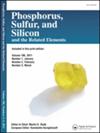Ultrasound-assisted facile synthesis of tin sulfide (SnS) nanostructures and their structural, optical, and morphological studies
IF 1.4
4区 化学
Q4 CHEMISTRY, INORGANIC & NUCLEAR
Phosphorus, Sulfur, and Silicon and the Related Elements
Pub Date : 2025-04-03
DOI:10.1080/10426507.2025.2484771
引用次数: 0
Abstract
In this study, we report the synthesis of tin sulfide (SnS) nanostructures via an ultrasonic-assisted sol–gel method, varying sulfur concentrations through different thiourea ratios. The formation of these nanostructures was confirmed through X-ray diffraction (XRD), scanning electron microscopy (SEM), Raman spectroscopy, and optical analysis. The SnS nanostructures exhibited a polycrystalline orthorhombic structure. The crystallite size of sample D1 was estimated at 3.30 nm, while increasing the molar concentration of thiourea in samples D2 and D3 resulted in reduced crystallite sizes of 3.14 nm and 3.08 nm, respectively. This size reduction suggests that thiourea plays a critical role in the nucleation and growth process during synthesis, where higher thiourea concentrations increase nucleation sites by providing excess of sulfur ions, thereby limiting crystallite growth. SEM images revealed that ultrasonic waves induce the transformation of disordered particle orientations into well-ordered nanospheres. The particle size consistently decreased with higher thiourea concentrations, forming larger clusters as individual particles aggregated into defined spherical structures. Energy-dispersive X-ray spectroscopy (EDX) confirmed the presence of Sn and S in the nanostructures, while Raman spectroscopy showed vibrational modes at 214 and 315 cm−1, indicating the successful formation of SnS nanostructures. Optical transmission studies revealed that the ultrasound-assisted SnS nanostructures possess a direct bandgap ranging from 1.85 to 1.87 eV, which falls within the visible light region. The bandgap variation with increasing thiourea concentration highlights the potential of these nanostructures for photovoltaic applications, offering improved conversion efficiency. Overall, the ultrasound-assisted synthesis route demonstrates significant promise for producing SnS nanostructures with tailored optical properties suitable for energy-related applications.
超声辅助下硫化锡纳米结构的快速合成及其结构、光学和形态学研究
在这项研究中,我们报道了通过超声波辅助溶胶-凝胶法合成硫化锡(SnS)纳米结构,通过不同的硫脲比例来改变硫浓度。通过x射线衍射(XRD)、扫描电镜(SEM)、拉曼光谱和光学分析证实了这些纳米结构的形成。SnS纳米结构呈多晶正交结构。D1样品的晶粒尺寸估计为3.30 nm,而D2和D3样品中硫脲的摩尔浓度增加导致晶粒尺寸分别减小3.14 nm和3.08 nm。这种尺寸的减小表明,在合成过程中,硫脲在成核和生长过程中起着关键作用,较高的硫脲浓度通过提供过量的硫离子增加成核位点,从而限制了晶体的生长。扫描电镜图像显示,超声波诱导无序的颗粒取向转变为有序的纳米球。随着硫脲浓度的升高,颗粒尺寸不断减小,形成更大的团簇,单个颗粒聚集成明确的球形结构。能量色散x射线光谱(EDX)证实了Sn和S在纳米结构中存在,而拉曼光谱显示214和315 cm−1的振动模式,表明SnS纳米结构成功形成。光传输研究表明,超声辅助的SnS纳米结构具有1.85 ~ 1.87 eV的直接带隙,处于可见光区。随着硫脲浓度的增加,带隙的变化凸显了这些纳米结构在光伏应用中的潜力,提供了更高的转换效率。总的来说,超声辅助合成路线显示出具有适合能源相关应用的定制光学特性的SnS纳米结构的巨大前景。
本文章由计算机程序翻译,如有差异,请以英文原文为准。
求助全文
约1分钟内获得全文
求助全文
来源期刊
CiteScore
2.60
自引率
7.70%
发文量
103
审稿时长
2.1 months
期刊介绍:
Phosphorus, Sulfur, and Silicon and the Related Elements is a monthly publication intended to disseminate current trends and novel methods to those working in the broad and interdisciplinary field of heteroatom chemistry.

 求助内容:
求助内容: 应助结果提醒方式:
应助结果提醒方式:


